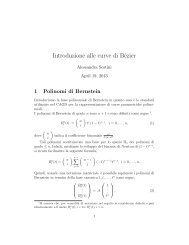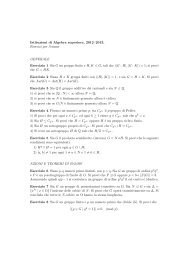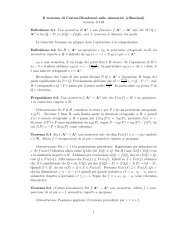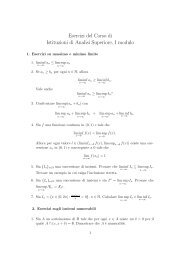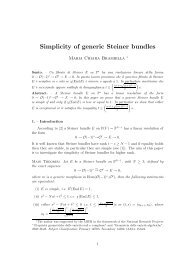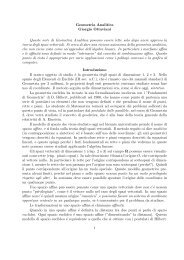Tesi di Laurea di Valentina Boccini - Dipartimento di Matematica e ...
Tesi di Laurea di Valentina Boccini - Dipartimento di Matematica e ...
Tesi di Laurea di Valentina Boccini - Dipartimento di Matematica e ...
Create successful ePaper yourself
Turn your PDF publications into a flip-book with our unique Google optimized e-Paper software.
CAPITOLO 3. COMPLEMENTI AL TEOREMA DI BARNING 88<br />
Sia infine (dk)k∈N che non termina con una successione infinita <strong>di</strong> 1 o <strong>di</strong><br />
3 e ve<strong>di</strong>amo come si <strong>di</strong>mostra il terzo punto.<br />
Fissato n ∈ N, definiamo l’insieme dei punti che hanno le prime n cifre<br />
del loro sviluppo coincidenti con le prime n cifre <strong>di</strong> questa sequenza:<br />
An := {t ∈ (0, 1) : G k (t) ∈ Idk , ∀k : 1 ≤ k ≤ n}.<br />
Per compattezza, si <strong>di</strong>mostra che <br />
n∈N An contiene almeno un punto; ma<br />
<strong>di</strong>am(An) → 0,<br />
⇒ <br />
An = {t0}.<br />
n∈N<br />
Quin<strong>di</strong> esiste un unico punto (x, y) ∈ Q che ha questo sviluppo.<br />
Esempi <strong>di</strong> sviluppi <strong>di</strong> punti (x, y) ∈ Q<br />
Sono riportati <strong>di</strong> seguito alcuni esempi <strong>di</strong> sviluppi <strong>di</strong> punti (x, y) ∈ Q, secondo<br />
la definizione data. Viene seguita la notazione:<br />
(x, y) = [d1, d2, . . .]<br />
Inoltre è stato specificato l’angolo normalizzato t corrispondente.<br />
• 3<br />
5<br />
• 4<br />
5<br />
• 5<br />
13<br />
• 21<br />
29<br />
<br />
4<br />
2<br />
, = [oe] t = 5<br />
π arctan <br />
4<br />
3<br />
, 3<br />
5<br />
<br />
2<br />
= [eo] t = π arctan 3<br />
4<br />
, 12<br />
13<br />
, 20<br />
29<br />
• 15 8 , 17 17<br />
• 7<br />
25<br />
• 65<br />
97<br />
•<br />
•<br />
•<br />
, 24<br />
25<br />
, 72<br />
97<br />
√<br />
2<br />
2 , √ 2<br />
2<br />
<br />
1<br />
2 , √ <br />
3<br />
2<br />
√ 3<br />
2<br />
, 1<br />
2<br />
<br />
2<br />
= [1, oe] t = π arctan 12<br />
5<br />
<br />
2<br />
= [2, oe] t = π arctan 20<br />
21<br />
= [3, oe] t = 2<br />
π arctan 8<br />
15<br />
<br />
2<br />
= [1, 1, oe] t = π arctan 24<br />
7<br />
<br />
2<br />
= [2, 3, oe] t = π arctan 72<br />
65<br />
<br />
<br />
= [2, 2, 2, 2, . . .] t = 1<br />
2<br />
= [1, 3, 1, 3, . . .] t = 2<br />
3<br />
= [3, 1, 3, 1, . . .] t = 1<br />
3




